Attersee
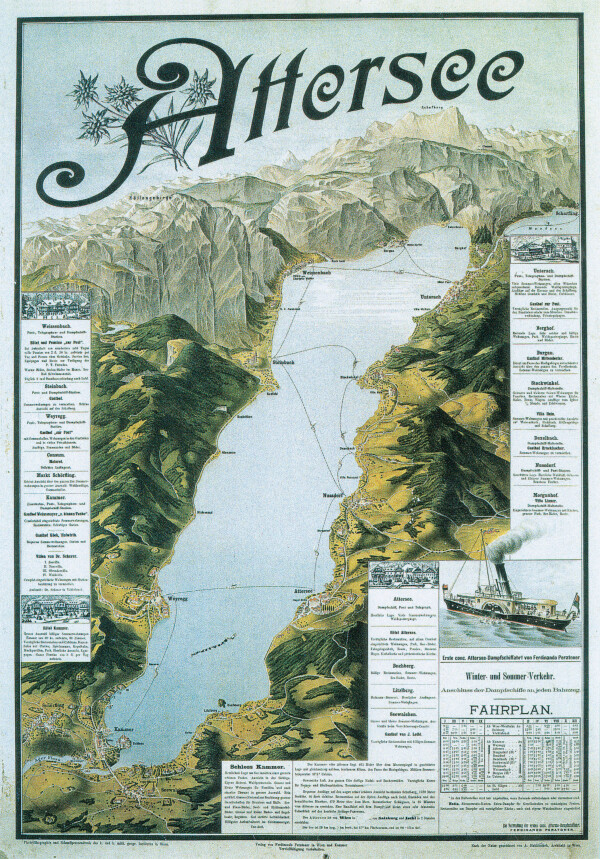
Advertising poster for the First Concessionary Attersee Steamship Company, around 1885
© Klimt Foundation, Vienna
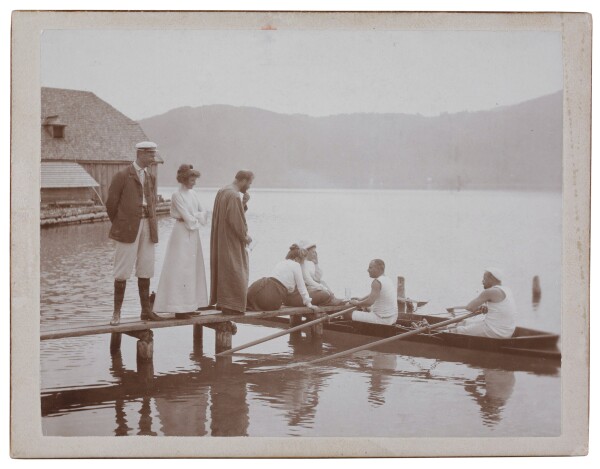
Gustav Klimt with friends on the jetty in Litzlberg, presumably summer 1905, Klimt Foundation
© Klimt Foundation, Vienna
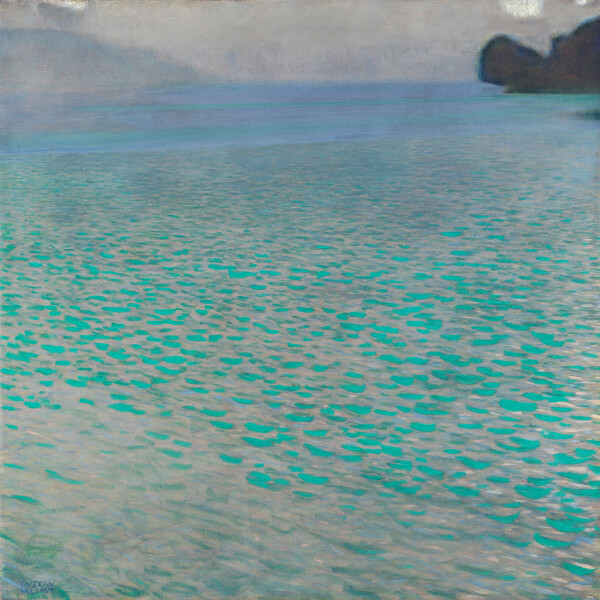
Gustav Klimt: On the Attersee, 1900, Leopold Museum
© Leopold Museum, Vienna
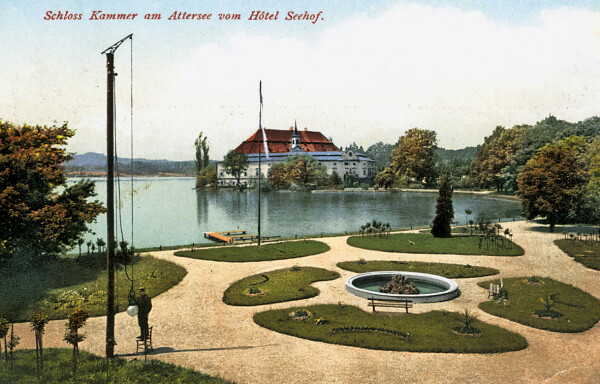
Park in front of the Hotel Seehof in Kammer, around 1906
© Klimt Foundation, Vienna
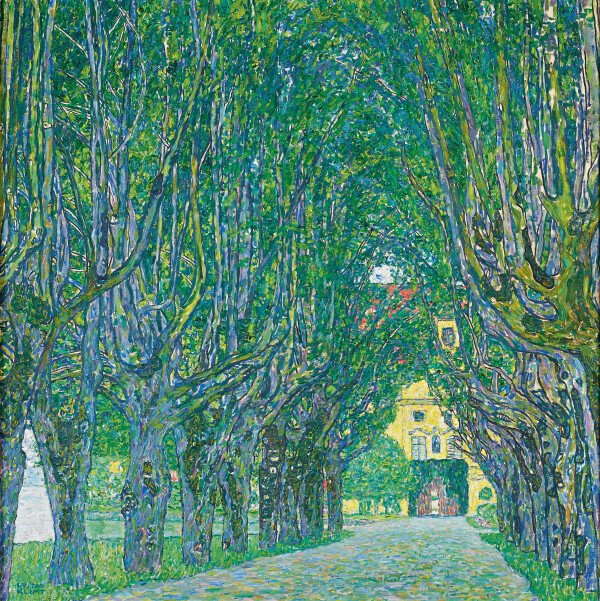
Gustav Klimt: Avenue in Front of Kammer Castle on the Attersee, 1912, Österreichische Galerie Belvedere
© Belvedere, Vienna
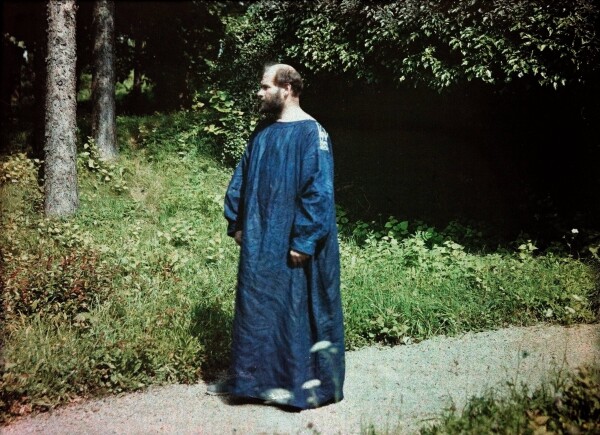
Friedrich Walker: Gustav Klimt in a painter's smock in the surroundings of Villa Paulick, 09/14/1913, Verbleib unbekannt
© APA-PictureDesk
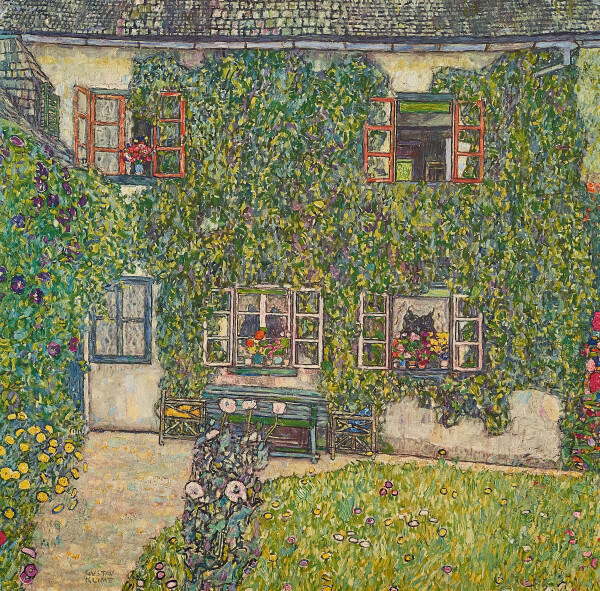
Gustav Klimt: Forester's House in Weissenbach on the Attersee II, 1914, Neue Galerie New York
© Klimt Foundation, Vienna
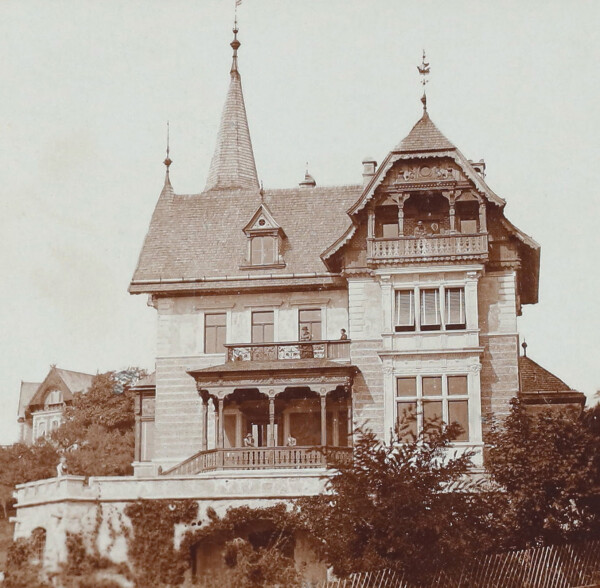
Villa Paulick in Seewalchen am Attersee, around 1901, Villa Paulick Collection, courtesy Klimt Foundation, Vienna
© Klimt Foundation, Vienna
From the second half of the 19th century, summer sojourns began to grow in popularity. Gustav Klimt indulged his longing to “be there,” meaning the turquoise Attersee, between 1900 and 1916. This is documented not only by a large amount of correspondence and snapshots but also by the majority of his landscape paintings, which reflect the impressions he received there.
The Attersee as a Summer Refuge
The discovery of the Attersee in the Upper-Austrian Salzkammergut region as a destination for summer sojourns began around the mid-19th century. The area around the lake quickly became a haven for artists and members of the urban bourgeoisie, while Bad Ischl – the holiday destination of choice for the Imperial family – was reserved to the aristocracy. The establishment of the Attersee Steamship Company, as well as of a railway connection linking Vienna and the region, made the lake accessible to tourists. This was followed by the construction of numerous hotels and villas, which could either be rented or bought as summer residences.
Gustav Klimt’s choice of this region for his summer holidays was determined by his ties to the Flöge and Paulick families. The artist used his sojourns on the lake to relax and derive artistic inspiration – the majority of his landscapes are inspired by motifs from the Attersee. Klimt’s recreation in the countryside can be reconstructed today owing to snapshots taken by photographer friends and to the artist’s extensive correspondence.
1900–1907: Litzlberg on the Attersee “a bath in the lake – with all caution”
Klimt first stayed on the turquoise lake in the summer of 1900 at the invitation of the Paulick family. His fencing partner Paul Bacher arranged for him to stay at the Brewery Inn in Litzlberg, situated on the north shore of the lake. The establishment consisted of a restaurant, rooms for rent and a boathouse. Until 1907, it was the artist’s preferred residence on the Attersee. Letters written to the mothers of his first sons – Maria Ucicka and Maria “Mizzi” Zimmermann – afford us insights into Klimt’s routine during his summer holidays. In mid-August 1902, he wrote to Zimmermann that he was in the habit of rising “early, around 6 o’clock, sometimes a little earlier, sometimes a little later” in order to paint in the nearby woods if the weather was fine. After breakfast, he would “take a bath in the lake – with all caution.” The rest of the day typically included further painting sessions in the surrounding landscape, as well as some reading and a nap at lunchtime for relaxation. In the evenings, his holiday program often comprised a “game of skittles.”
Klimt found manifold sources of inspiration in the region, and was able to draw from the variety of the landscape, which included not only the lakeshore – he created two “frames full of lake water” – but also trees laden with fruit, colorful cottage gardens and mystical views into forests. His first few stays, especially, were further shaped by his work on The Beethoven Frieze (1901–1902, Österreichische Galerie Belvedere).
1908–1912: Villa Oleander in Kammerl am Attersee “We will spend the summer in ‘Kammerl’ again”
From 1908 onwards, Klimt and the Flöge family stayed at Villa Oleander, built already in 1872 as a holiday lodge. This residence, which is now privately owned, also boasted direct access to the lake, and belonged to the private villas of the Hôtel Seehof complex, which included bathing beaches and generous parks. It was especially during the idyllic summer sojourns spent in Kammerl that the artist embarked on extensive boat excursions, as illustrated by a variety of photographs of Klimt and Emilie Flöge.
The Villa Oleander played an important role in the preparatory work for The Stoclet Frieze (1905–1911, private collection). Already during his first summer there, Klimt began working on the preliminary drawings for the famous mosaic frieze for the dining room of the Palais Stoclet in Brussels. Klimt regularly feared that he would have to spend the summer in Vienna to be able to complete this complex commission. In 1914, during a visit to the Brussels palace, he reminisced about this time in a postcard to Emilie:
“[…] all the memories come flooding back […] memories of the wall in Kammerl, of the toils, the joys and the sorrows of that time […]”
Aside from this commission, Klimt’s main motif during this period in his summer sojourns was Kammer Castle. He captured the stately home and its picturesque gardens seven times in oil on canvas.
1913: A Brief Attersee Intermezzo
The summer of 1913 was dominated by an extended stay on Lake Garda. Prior to this, Klimt had spent a few days at the turquoise Attersee already in the spring, as illustrated by photographs showing him with Therese and Gertrude “Trudl” Flöge on the jetty of Villa Paulick. Photographs by Friedrich G. Walker, which were taken in mid-September of that year, document another brief stay on the Attersee. These photographs are especially important, as they are the only known color photographs of Gustav Klimt and Emilie Flöge, created in the garden and environs of Villa Paulick.
1914–1916: Weißenbach am Attersee “I have half a mind to pack everything in and to join you”
Klimt spent his last three summer sojourns on the quieter southern shore of the lake, at the entrance to Weißenbach Valley. There were two reason for this: on the one hand, he increasingly sought peace and quiet, and on the other, Villa Oleander had been rented out to other summer guests since the summer of 1913. Klimt rented a forester’s lodge, which still exists today, and which inspired two of his paintings. The Flöge family stayed at Haus Donner, situated in nearby Steinbach am Attersee.
In terms of motifs, Klimt captured not only the lush landscape around him but also Unterach on the opposite lakeshore. Moreover, he returned once more to where he first used to stay, memorializing Litzlberg in two paintings.
In 1916, the year of his last summer sojourn, Klimt was visited on the Attersee by Friederike Maria Beer, whom he had portrayed shortly before. The portrait had been commissioned by Hans Böhler, a cousin of Erich Böhler’s, who, in turn, bought Litzlberg Island on the northern shore of the lake in 1916.
Villa Paulick as a Meeting Place
Though Klimt changed the location of his summer residence throughout the years, there was one inspiring constant on the Attersee, which he visited regularly: the Historicist Villa Paulick in Seewalchen am Attersee, built by the architects Friedrich König and Rudolf Feldscharek, and completed in 1877.
Already during their Attersee debut in 1900, Klimt and Emilie Flöge made an entry into the villa’s guestbook. Peter Altenberg, Otto Prutscher, Carl Moll and Richard Teschner were also among the Paulicks’ welcome guests. The Imperial-Royal court carpenter Friedrich Georg Paulick was the owner of this imposing villa. An architectural gem, it was built in the style of Historicism, but in terms of its furnishings, tableware and arts-and-crafts objects, revealed clear influences of Jugendstil and the Wiener Werkstätte. Today, the villa, whose original condition has largely been preserved, is privately owned.
Literature and sources
- Brief mit Kuvert von Gustav Klimt am Attersee an Maria Zimmermann in Villach (17.08.1902). S64/18.
- Ludwig Hevesi: Acht Jahre Sezession (März 1897–Juni 1905). Kritik – Polemik – Chronik, Vienna 1906, S. 318.
- Ansichtskarte von Gustav Klimt in Wien an Emilie Flöge in Paris, 1. Karte (Morgen) (10.03.1909).
- Ansichtskarte von Gustav Klimt in Brüssel an Emilie Flöge in Wien, 2. Karte (18.05.1914). Autogr. 959/50-2, .
- Ansichtskarte von Gustav Klimt in Wien an Emilie Flöge in Seewalchen am Attersee (24.06.1915). Autogr. 959/51-1, .
- Johannes Dobai: Gustav Klimt. Die Landschaften, Salzburg 1981.
- Stephan Koja (Hg.): Gustav Klimt. Landschaften, Ausst.-Kat., Upper Belvedere (Vienna), 23.10.2002–23.02.2003, Munich 2002.
- Sandra Tretter, Peter Weinhäupl (Hg.): Gustav Klimt. Sommerfrische am Attersee 1900-1916, Vienna 2022.

